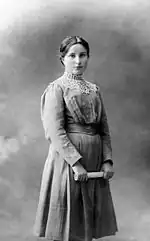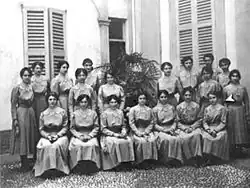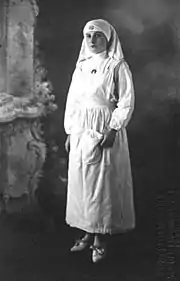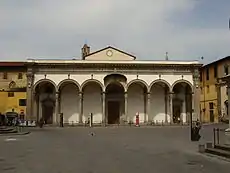Maria Valtorta
Maria Valtorta (14 March 1897 – 12 October 1961) was a Catholic Italian writer. She was a Franciscan tertiary and a lay member of the Servants of Mary who reported personal conversations with, and dictations from, Jesus Christ. She lived much of her life bedridden in Viareggio in Tuscany where she died in 1961.[1] She is buried at the grand cloister of the Basilica of Santissima Annunziata in Florence.[2]
Maria Valtorta | |
|---|---|
 Maria Valtorta at age 15, 1912 | |
| Born | 14 March 1897 Caserta, Italy |
| Died | 12 October 1961 (aged 64) Viareggio, Italy |
| Resting place | Basilica of Santissima Annunziata, Florence |
| Nationality | Italian |
| Genre | Christian mysticism, visions |
| Notable works | The Poem of the Man-God The Book of Azariah |
She is best known for her 5,000 page book The Poem of the Man-God, first published in 1956 and later titled The Gospel as Revealed to Me. The book is based on 10,000 of the 15,000 pages in her handwritten notebooks. The 10,000 pages were mostly written from 1944-1947 and detail the life of Jesus as an extended narrative of the gospels. These handwritten pages were typed on separate pages by her spiritual advisor, Father Romualdo Migliorini, O.S.M, and chronologically reassembled into a book.[3] The additional 5,000 pages were later published as separate books.[4][5]
Her main book was placed on the (now abolished) Index Librorum Prohibitorum in 1959, and has remained controversial since its publication. Various Biblical experts, historians and scientists continue to support and criticize the book to this day, and yearly conferences on the scientific and theological aspects of her writings are held in Italy.[4][6][7][8]
Life
Early life and education
Valtorta was born in 1897 in Caserta, just north of Naples, in the Campania region of Italy, where her father's military regiment was stationed.[9][10] She was the only child of parents who had both been born in the Lombardy region. Her father, Giuseppe, was in the Italian cavalry; her mother, Iside, was a teacher of French.[10][4] In 1898 the family moved with his father's regiment to Faenza in Emilia-Romagna.[9][11]
In 1900 her father's regiment moved to Milan and the Valtorta family lived in Lombardy until his retirement about 12 years later.[9][4][12] In 1907 the regiment moved to Voghera where Maria attended school and where the park "Gardens of Maria Valtorta" was inaugurated in her name in 2013.[13][10]
In March 1909, just before her 12th birthday, Maria was sent to the Collegio Bianconi boarding school in Monza, just north of Milan.[11][4][14] She studied there until March 1913 when just before her 16th birthday she had to leave Lombardy with her family for Florence, in Tuscany, due to her father's retirement from the military.[11][14]
A decade in Florence

The First World War (1914-1918) started about a year after the Valtorta family had settled in Florence, and Italy entered the war in April 1915 on the side of the allies.[15][11] In 1917 Valtorta volunteered as a Samaritan nurse, and for 18 months worked at a military hospital set up in Florence to care for the wounded soldiers who had returned from the war.[15][11][16]
In March 1920, when she was 23 years old, Maria was walking on a street in Florence with her mother, when the young and delinquent son of her mother's dress maker (who was a fascist socialist) struck her in the back with an iron bar and shouted a slogan against the wealthy and the bourgeoisie.[15][4][11]
As a result of that injury, she was confined to bed for a few months and although she seemed to have recovered, the complications from that incident eventually confined her to bed for 28 years, from April 1934 to the end of her life.[4][12]
Settling in Viareggio
In October 1924, when Maria was 27 years old, the Valtorta family moved from Florence to Viareggio, on the coast of the Mediterranean, as part of her father's final retirement.[17][12][4] Over time, Maria's back injury affected her health in a progressive manner, and the last day she was able to leave her house on her own, given her high level of fatigue, was 4 January 1933. From 1 April 1934 she was no longer able to leave her bed at all.[4][11]
In 1935, a year after she was bed-ridden, Martha Diciotti began to care for her.[5] Valtorta's father died in 1935 and her mother in 1943, after which she was mostly alone in the house, with Martha Diciotti taking care of her to the end of her life.[17][5] After 1941, except for a brief wartime evacuation to Sant’ Andrea di Compito in Lucca, from April to December 1944, during the Second World War, Valtorta's life was spent in her bed at her house in Via Antonio Fratti in Viareggio.[5][17][4]
In 1942, Valtorta was visited by Fr. Migliorini of the Servants of Mary, who became her spiritual director and suggested to her to write her autobiography, which she completed before starting her other writings in 1943.[4][18][11]
In her autobiography Valtorta wrote that both in Florance and Viareggio, she had deep religious experiences which transformed her life.[17][4] Valtorta wrote that in 1925, soon after moving to Viareggio, and several years before becoming bedridden, she was influenced by the autobiography of Thérèse de Lisieux, and made a vow to offer herself to God as a victim soul and to renew that offer each day.[17][1][16]
From handwriting to publication

After completing her autobiography, in 1943 Valtorta began handwriting a series of what she claimed were messages from Jesus.[4][3] From 1943 to 1947 Valtorta hand wrote about 15,000 pages in her notebooks, 10,000 of which were later selected as the basis of her main book The Poem of the Man-God, and the rest were gradually organized and published after her death.[5][4]
Valtorta wrote her text in a series of 122 school notebooks purchased for her by her priest.[5] She used a fountain pen to write in her numbered notebooks, but did not write the episodes for her Poem in chronological order, and instead included markings as to how they should be ordered after the book had been completed.[5][16]
Valtorta was initially reluctant to have any of her handwritten notes published but in 1947 her priest convinced her to agree to their publication.[4][19] But the initial four volume edition of the book was published without an author name.[20]
In February 1948, Fr. Miglorini, Fr. Corrado Berti, and their prior Fr. Chechin had a private audience with Pope Pius XII about her work, which was reported in the L'Osservatore Romano.[21] Although Pius XII was positive about the book, in 1949 the Holy Office summoned Fr Berti and ordered him not to publish the book.[6]
In 1952 Michele Pisani agreed to publish Valtorta's work and a contract was signed by Valtorta in October 1952.[5] The first edition of her Poem was published in 1956 and the Pisani form has since continued to publish the rest of her writings,[5]
Joachim Bouflet states that most of Maria Valtorta's life is known "only by the autobiography she wrote when she was 46 years old".[22] However, at least two biographies of Valtorta based on taped interviews with people who personally knew her have been published, one titled Ricordi di Donne Che Conobbero Maria Valtorta, (Memories of Women Who Knew Maria Valtorta)[23] and another titled Una Vita con Maria Valtorta: Testimonianze di Marta Diciotti (A Life with Maria Valtorta: Testimony of Marta Diciotti).[24]
Death, burial and legacy

Maria Valtorta died in 1961, at age 64, and was buried in the town cemetery in Viareggio.[4][5] Later, in 1973, her remains were moved to the chapel of the great cloister of the Basilica della Santissima Annunziata in Florence.[5][2] Presiding over the services at Valtorta's "privileged burial" and the relocation of her remains from Viareggio to the Santissima Annunziata Basilica, the mother church of the Servants of Mary was Msgr. Gabriel M. Roschini, O.S.M.[25]
Before her death in 1961 Maria Valtorta assigned her assistant Marta Diciotti as the heir to her writings, and in 2001 Marta Diciotti in turn assigned Emilio and Claudia Pisani as her heirs.[5] The Pisanis then formed a foundation dedicated to the works of Maria Valtorta.[5] Since Valtorta's death the Pisani organization has been publishing books based on Valtorta's handwritten notebooks and her Poem has been translated into over 20 languages.[5]
Separately, the Maria Valtorta Foundation was formed in 2009 in Viareggio by Fr. Ernesto Zucchini, a professor of theology, and has been holding yearly conferences on the writings of Valtorta in Viareggio, and presentations about her at various locations in Italy.[26][7][27][28] The conference on 12 October 2021 (the 60th anniversary of Valtorta's death) was attended by Msgr. Paolo Giulietti, the Archbishop of Lucca who has jurisdiction over the city of Viareggio, and he gave a talk about the life and writings of Valtorta.[8]
Books by Maria Valtorta
The Poem of the Man-God
Valtorta's best known book is the "Poem of the Man God". Valtorta signed a contract with Michele Pisani in 1952 to publish the book, and the first of the four volumes was published without an author name under the Italian title Il Poema di Gesu (i.e. "The Poem of Jesus").[29] The other three volumes were also published without an author name, but had a different Italian title: Il Poema dell'Uomo-Dio (i.e. "The Poem of the Man-God").
On 16 December 1959, the Holy Office placed the 4-volume work on the Index of Forbidden Books;[30] this was formally reported in the 6 January 1960 issue of L'Osservatore Romano.[29] The front page of this issue of L'Osservatore also included an anonymously written article titled "A Badly Fictionalized Life of Jesus".[20][31] According to Paul Collins the article was critical of the book, and stated that the only information about the author was that her first name may be Maria. The article stated that the book was placed on the Index because it went against rule 1385 of the Code of Canon Law which required an imprimatur prior to publication.[6][20]
On 15 June 1966, the Sacred Congregation for the Doctrine of the Faith abolished the Index, and all formal sanctions against reading books placed on the Index ended.[32][33][6]
Other books by Valtorta

After Valtorta's death in 1961 several books based on material contained in her handwritten notebooks were gradually published.[5] Her autobiography, which she had completed in 1943 was published in 1969.[9] In 1972 the Book of Azariah was published, based on material she had written every Sunday from the end of February 1946 to the beginning of February 1947.[34][35] The book contains spiritual lessons about the Catholic masses said on those Sundays.[34][35] Valtorta wrote that the lessons were given to her by Azariah, her guardian angel.[35] [34]
In 1976 the first of the four volumes of her "Notebooks" were published, based on material interspersed with the text for her Poem within the 122 school notebooks which she had used to write her text was published in Italian.[16][5][36] In 1977 the book "Lessons on the Epistle of Paul to the Romans" was published in Italian, containing comments on Paul's Letter to the Romans.[37] In 2006 additional unpublished pages from her handwritten notebooks were gathered and published as the "Small Notebooks", in Italian.[38] Over time Valtorta's books were gradually translated into other languages beside Italian.[16][5]
Works
- Maria Valtorta, The Poem of the Man-God, ASIN B001DBLAVS,
- Maria Valtorta, The Gospel as Revealed to Me, ASIN B01E6291GQ
- Maria Valtorta, The Book of Azariah, ASIN 8879870130
- Maria Valtorta, The End Times, ASIN 2894202210
- Maria Valtorta, Mary Magdalene, ASIN 8879871323
- Maria Valtorta, Lessons on the Epistle of St. Paul to the Romans, ASIN B091NDKRTQ
- Maria Valtorta, Valtorta and Ferri, ASIN 887987134X
- Maria Valtorta, The Notebooks 1943, ASIN 8879870327
- Maria Valtorta, The Notebooks 1944, ASIN 8879870424
- Maria Valtorta, The Notebooks 1945–1950, ASIN 8879870882
- Maria Valtorta, The Little Notebooks
- Maria Valtorta, Autobiography, ASIN B000BY4XKS
See also
References
- Freze, Michael (1993). Voices, Visions, and Apparitions. OSV Publishing. p. 251. ISBN 087973454X.
- Fortune, Jane (2011). To Florence con Amore: 90 Ways to Love the City (2nd ed.). Florentine Press. p. 50. ISBN 978-8890243486.
- Lindsey, David Michael (2001). The Woman and the Dragon: Apparitions of Mary. Pelican Publishing Company. pp. 324–326. ISBN 978-1565547315.
- Laurentin, René; Debroise, François-Michel; Lavère, Jean-François (2012). Dictionnaire des Personnages de l'Evangile Selon Maria Valtorta (in French). Salvator. pp. 9–19. ISBN 978-2706709616.
- Stefano Lorenzetti "Tipi Italiani" Il Giornale 24 August 2014
- Pillari, Anthony (2017). "The Current Juridic and Moral Value of the Index of Forbidden Books" (PDF). Saint Paul University, Faculty of Canon Law. pp. 26, 36. Archived (PDF) from the original on 2 July 2023. Retrieved 2 July 2023.
- "Viareggio, convegno su Maria Valtorta" Toscana Oggi, 19 October 2017
- La Nazione, "Nuovi studi e scoperte sulla tomba di S.Pietro", 23 October 2021.
- Maria Valtorta, Autobiography, Editions Paulines, 1991, Chapter 1
- Caserta News 16 May 2013
- Massimo Olmi, Indagine sulla croce di Cristo, La Fontana di Siloe, 2015, Section "Visioni della Croce"
- Pasquale Amato, Il Tempo Di Primavera, Pellegrini Editore, pp 206
- La Provincia Pavese, "Il parco per Maria Valtorta" 12 May 2013
- Maria Valtorta, Autobiography, Editions Paulines, 1991, Chapter 2
- Maria Valtorta, Autobiography, Editions Paulines, 1991, Chapter 3
- Laurentin, René; Debroise, François-Michel (2012). Indagine su Maria: Le Rivelazioni dei Mistici sulla Vita della Madonna (in Italian). Mondadori. Chap. 12. ISBN 978-8804615880.
- Maria Valtorta, Autobiography, Editions Paulines, 1991, Chapter 4
- Maria Valtorta, Autobiography, Editions Paulines, 1991, Chapter 7
- Rookey O.S.M., Peter M., Shepherd of Souls: The Virtuous Life of Saint Anthony Pucci, (Jun 2003) ISBN 1891280449 CMJ Marian Press pp. 1-3
- "Una vita de Jesù malamente romanzata" (PDF). L'Osservatore Romano (in Italian). No. 4. 6 January 1960. p. 1. Archived (PDF) from the original on 11 May 2023. Retrieved 14 June 2023.
- L'Osservatore Romano 27 February 1948
- Bouflet, Joachim (2023). "Fraudes Mystiques Récentes – Maria Valtorta (1897-1961) – Anachronismes et incongruités". Impostures mystiques [Mystical Frauds] (in French). Éditions du Cerf. ISBN 978-2-204-15520-5.
- Centoni, Albo (1998). Ricordi di Donne Che Conobbero Maria Valtorta [Memories of Women Who Knew Maria Valtorta] (in Italian). Centro Editoriale Valtortiano. ISBN 978-8879870405.
- Centoni, Albo (1987). Una Vita con Maria Valtorta: Testimonianze di Marta Diciotti [A life with Maria Valtorta: Testimony of Marta Diciotti] (in Italian). Centro Editoriale Valtortiano. ISBN 978-8879870443.
- Publisher's Notice in the Second Italian Edition (1986), reprinted in English Edition, Gabriel Roschini, O.S.M. (1989). The Virgin Mary in the Writings of Maria Valtorta (English Edition). Kolbe's Publication Inc.ISBN 2-920285-08-4
- Rita Ricci, "Alla scoperta dell’vangelo di Maria Valtorta" Zenit 16 October 2016
- "Indagine sugli scritti di Maria Valtorta" La Nazione 14 November 2020
- "Don Zucchini ricorda la figura di Maria Valtorta" Il Resto del Carlino, 23 May 2023
- "Suprema Sacra Congregatio Sanctii Officii: Decretum Proscriptio Librorum" (PDF). L'Osservatore Romano (in Latin). No. 4. 6 January 1960. p. 1. Archived (PDF) from the original on 11 May 2023. Retrieved 14 June 2023.
- "Acta Apostolicae Sedis: Commentarium Officiale" (PDF). The Holy See. Annus LII - Series III - Vol. II (in Latin). 30 January 1960. p. 60. Archived (PDF) from the original on 14 June 2023. Retrieved 14 June 2023.
- "Library : A Badly Fictionalized Life of Jesus". www.catholicculture.org. Retrieved 10 September 2017.
- Ottaviani, Alfredo (15 June 1966). "Notificatio" (PDF). L'Osservatore Romano (in Latin). No. 136. p. 1. Archived (PDF) from the original on 11 May 2023. Retrieved 14 June 2023.
- Collins, Paul (2001). From Inquisition to Freedom. Continuum International Publishing. p. 18. ISBN 978-0826454157.
- Laurentin, René; Debroise, François-Michel (2012). Indagine su Maria: Le Rivelazioni dei Mistici sulla Vita della Madonna (in Italian). Mondadori. Bibliografia section. ISBN 978-8804615880.
- Maria Valtorta, The Book of Azaria, 1976, 978-8879871433
- Maria Valtorta "I quaderni del 1943" 1976 ISBN 8879871358
- Maria Valtorta "Lezioni sull'Epistola di Paolo ai Romani" 1977 ISBN 8879871501
- Maria Valtorta "Quadernetti " 2006 ISBN 8879871390